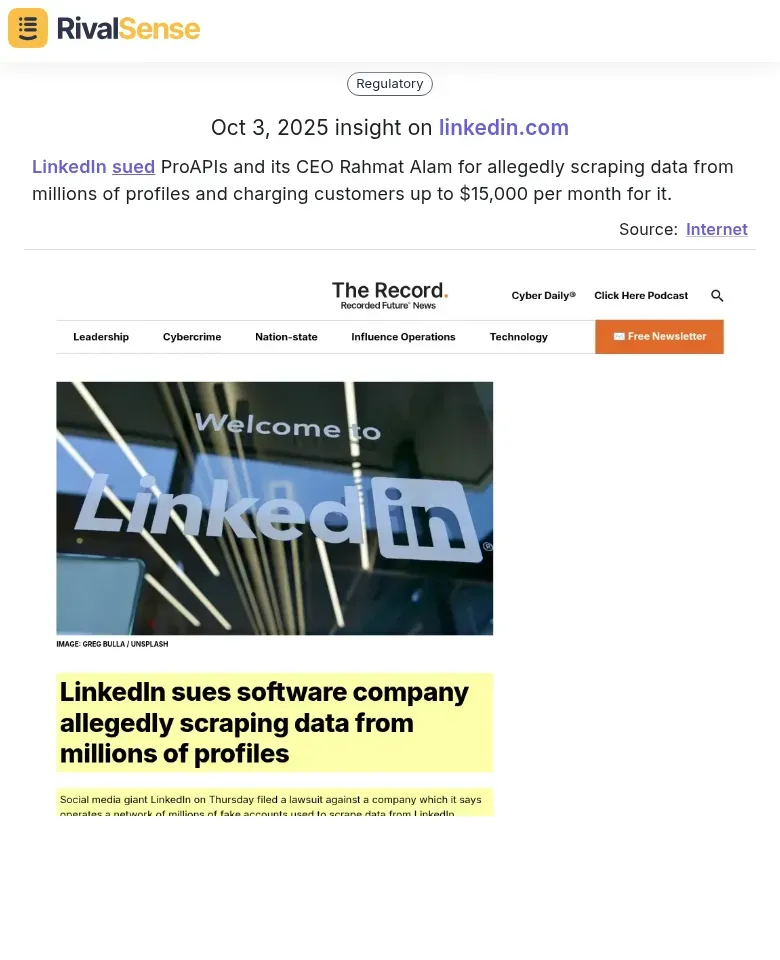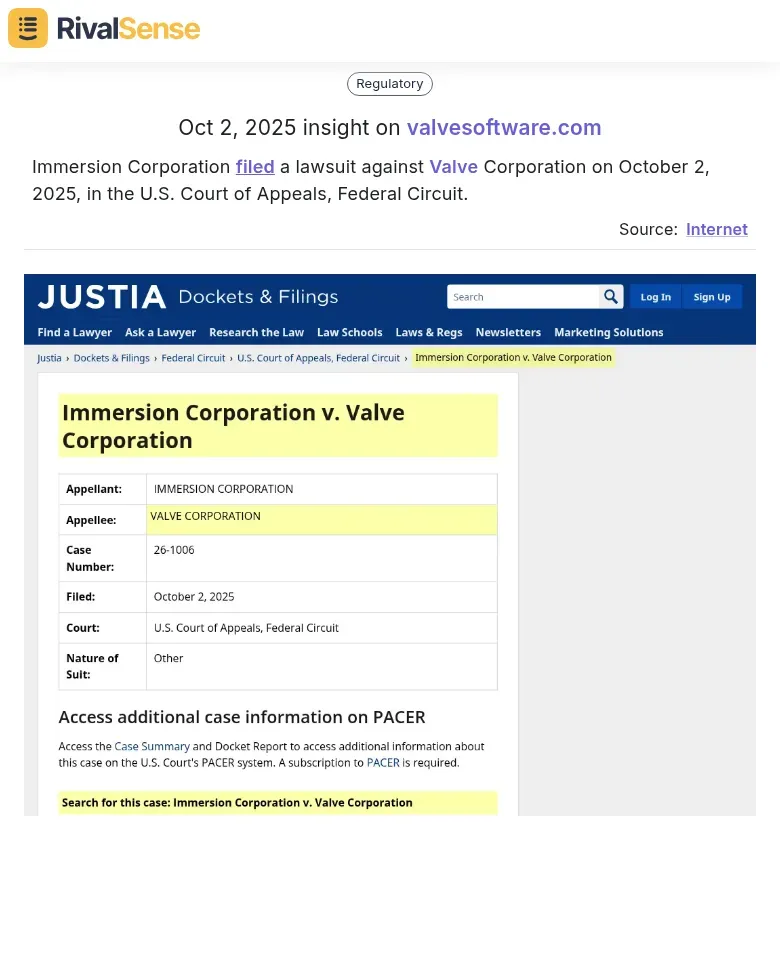Streamline Regulatory Compliance with Competitor Intelligence Insights
In today's complex regulatory landscape, competitor intelligence serves as your early warning system for emerging compliance risks. By monitoring competitors' regulatory filings, legal challenges, and market actions, you gain foresight into potential regulatory shifts before they impact your business. This proactive approach transforms compliance from a reactive burden into a strategic advantage.
Consider real-world examples: when a major fintech competitor faced GDPR fines, others in the sector immediately strengthened their data protection protocols, avoiding similar penalties. Similarly, automotive companies tracking Tesla's regulatory battles gained insights into evolving EV safety standards.
🔍 Practical steps to integrate competitor intelligence into compliance:
- Monitor competitors' SEC filings and regulatory disclosures weekly
- Track industry-wide legal settlements and enforcement actions
- Analyze competitor product recalls for pattern recognition
- Subscribe to regulatory alert services covering your key competitors
- Conduct quarterly competitor compliance risk assessments
This intelligence-driven approach not only prevents costly violations but positions your organization as an industry leader in compliance excellence, protecting both market position and reputation.
Learning from Security Breaches: Data Protection and Cybersecurity Compliance
In an era of escalating cyber threats, data breaches can cripple businesses and trigger regulatory penalties. Monitoring how competitors handle security incidents provides a roadmap for fortifying your own defenses and staying compliant with evolving standards like GDPR or CCPA. By analyzing the fallout from breaches, you can identify common vulnerabilities and adjust your cybersecurity strategies proactively.
For example, RivalSense recently tracked that Discord confirmed a limited but intrusive security breach that compromised some user data. This insight is valuable because it underscores the importance of real-time monitoring for emerging data protection risks, enabling you to benchmark your security measures and avoid similar pitfalls.

Use these incidents to forecast enforcement priorities and extract lessons on incident response. Implement this checklist to stay ahead:
- ✅ Regularly review competitor breach reports
- ✅ Update incident response plans based on industry failures
- ✅ Conduct tabletop exercises simulating similar scenarios
- ✅ Enhance employee training on phishing and access controls
This proactive stance not only mitigates risks but also builds trust with customers and regulators.
Navigating Intellectual Property and Data Scraping Regulations
Intellectual property disputes and data scraping cases are becoming more frequent, with regulators tightening rules around data usage and ownership. Understanding how competitors navigate these legal waters can help you establish compliant data practices and avoid costly litigation. By learning from their missteps, you can refine your approaches to data collection and IP management.
RivalSense captured a key example: LinkedIn sued ProAPIs and its CEO Rahmat Alam for allegedly scraping data from millions of profiles and charging customers up to $15,000 per month for it. Tracking such lawsuits is crucial because it reveals permissible data collection boundaries and highlights red flags, like unauthorized access or consent issues, allowing you to align your strategies with legal standards.

📋 Compliance checklist for IP and data scraping:
- Review competitor lawsuits and regulatory filings for IP trends
- Implement rate-limiting and attribution in data scraping to avoid infringement
- Consult legal experts on evolving laws like the EU's Digital Services Act
- Monitor emerging trends, such as increased copyright claims over AI-generated content
By staying informed, you can adapt your data practices to minimize legal exposure and foster innovation within safe boundaries.
Patent Litigation Insights: Technology and Innovation Compliance
Patent litigation often signals where regulatory scrutiny is intensifying, especially in fast-moving sectors like AI, fintech, and biotech. Observing competitors' legal battles over intellectual property can reveal upcoming compliance hurdles and guide your R&D investments. This foresight helps you align innovation with regulatory expectations, reducing the risk of penalties and delays.
A recent RivalSense insight showed that Immersion Corporation filed a lawsuit against Valve Corporation on October 2, 2025, in the U.S. Court of Appeals, Federal Circuit. Following such patent disputes is valuable because it uncovers trends in technology regulation, such as demands for transparency or ethical standards, enabling you to proactively adjust your IP strategy and stay compliant.

⚙️ Practical steps for leveraging patent insights:
- Monitor competitor patent filings and disputes quarterly
- Identify common litigation topics (e.g., data handling, AI ethics)
- Adapt your IP strategy to emphasize compliance-friendly innovations
- Use insights to guide internal audits and training sessions
Learning from others' legal challenges not only mitigates risks but also positions your company as a leader in ethical innovation.
Building a Proactive Compliance Framework with Competitor Intelligence
Integrating competitor monitoring into your risk assessment processes shifts compliance from a reactive task to a strategic advantage. By tracking regulatory filings, enforcement actions, and public statements, you can identify emerging threats early and adapt your policies accordingly. This dynamic approach ensures your framework evolves with industry standards, reducing vulnerabilities.
For instance, if competitors face fines for privacy violations, you can preemptively audit your data practices. Develop early warning systems by setting up alerts for competitor regulatory challenges using specialized tools.
📊 Steps to build a robust compliance framework:
- Identify top competitors and analyze their compliance histories
- Use monitoring tools for real-time alerts on regulatory changes
- Regularly update risk assessments based on competitor insights
- Train teams on findings to foster a culture of vigilance
💡 Tips for success: Focus on high-impact regulations in your sector and collaborate with legal teams to interpret competitor actions. This proactive stance not only cuts penalties but also enhances stakeholder trust.
Conclusion: Transforming Compliance from Burden to Competitive Advantage
Regulatory compliance, when powered by competitor intelligence, evolves from a cost center to a key differentiator. By systematically tracking how peers handle regulatory shifts, you gain actionable insights to not just meet but exceed standards, positioning your company as an industry leader in compliance excellence.
Build organizational resilience through continuous monitoring and implement these steps:
- Set up automated alerts for regulatory updates affecting your sector
- Analyze competitors' compliance strategies and public disclosures
- Benchmark your compliance maturity against industry standards
- Document lessons from competitors' successes and failures
Position your company as a regulatory leader by:
- Proactively sharing compliance insights with stakeholders
- Developing best practices that go beyond minimum requirements
- Leveraging compliance excellence in marketing and sales
- Creating dashboards for real-time oversight
Transform compliance into a proactive opportunity. Use competitor intelligence to anticipate changes, adapt faster, and build trust that drives sustainable growth.
Ready to streamline your compliance strategy? Try RivalSense for free at https://rivalsense.co/ to get your first competitor report today and stay ahead of regulatory risks with timely insights!
📚 Read more
👉 How to Decode Competitor Moves: Insights from Holland & Barrett's Store Expansion
👉 The Ultimate Guide to Competitor Market Share Analysis: How to Gain Your Competitive Edge
👉 Track Competitor Partnerships: A Media Buying Agency's Strategic Guide
👉 How Kérastase's Launch Alert Drove Competitor's Strategic Move
